This is How the US Plans to Neutralize North Korea's Nuclear Weapons
A recent document published by the Pentagon outlines the US doctrine for neutralizing weapons of mass destruction (WMDs)
Dan Arkin
| 30/07/2017
The Pentagon released a manual that lays out how the United States might destroy North Korea’s nuclear weapons. The document, named Army Techniques Publication No. 3-90.40, "Combined Arms Countering Weapons of Mass Destruction," explains the US doctrine for neutralizing WMDs. The guidelines focus on counter-WMD combined-arms operations by brigade combat teams (BCTs). It explains how regular Army combat brigades should deal with nuclear, biological or chemical weapons.
While there is no mention of North Korea in the document, many of the recommendations would apply should US ground forces enter North Korea. Regardless of whether the goal is regime change, a punitive incursion or destroying WMDs, it is quite possible that American troops would encounter production, storage or launch facilities for weapons of mass destruction. According to The National Interest, many of the guidelines seem to apply less to an active enemy nation with weapons of mass destruction, and more to a collapsing state whose WMD sites must be secured. Many of these operations would seem to involve US capabilities and decision-making at a high level.
The Army manual describes counter-WMD efforts as primarily a land-based operation. "CWMD operations require a unique blend of capabilities within the force that is tailored to the specific target," including at least eighteen different tasks, from decontamination and forensics to earth-moving and information operations. Special emphasis is placed on reconnaissance and intelligence collection to identify WMD sites. The manual distinguishes between seizing WMDs, which means using force to capture them from the enemy, and securing sites so that no one manages to walk off with a nuclear device.
Meanwhile, tensions continue to climb over North Korea, which conducted another test of an intercontinental ballistic missile (ICBM) on Friday. According to Pyongyang, the latest launch proved its ability to strike the US mainland. In direct response to the missile test, the United States flew two supersonic B-1B bombers over the Korean peninsula in a show of force on Sunday. The two B-1 bombers took off from Andersen Air Force Base in Guam before flying over Japanese airspace and being joined by two Japan Air Self Defense Force fighter jets. The B-1s then flew over the Korean Peninsula and the Osan Air Base in South Korea. According to a US statement, the mission lasted 10 hours and included formation and intercept training.
A recent document published by the Pentagon outlines the US doctrine for neutralizing weapons of mass destruction (WMDs)
The Pentagon released a manual that lays out how the United States might destroy North Korea’s nuclear weapons. The document, named Army Techniques Publication No. 3-90.40, "Combined Arms Countering Weapons of Mass Destruction," explains the US doctrine for neutralizing WMDs. The guidelines focus on counter-WMD combined-arms operations by brigade combat teams (BCTs). It explains how regular Army combat brigades should deal with nuclear, biological or chemical weapons.
While there is no mention of North Korea in the document, many of the recommendations would apply should US ground forces enter North Korea. Regardless of whether the goal is regime change, a punitive incursion or destroying WMDs, it is quite possible that American troops would encounter production, storage or launch facilities for weapons of mass destruction. According to The National Interest, many of the guidelines seem to apply less to an active enemy nation with weapons of mass destruction, and more to a collapsing state whose WMD sites must be secured. Many of these operations would seem to involve US capabilities and decision-making at a high level.
The Army manual describes counter-WMD efforts as primarily a land-based operation. "CWMD operations require a unique blend of capabilities within the force that is tailored to the specific target," including at least eighteen different tasks, from decontamination and forensics to earth-moving and information operations. Special emphasis is placed on reconnaissance and intelligence collection to identify WMD sites. The manual distinguishes between seizing WMDs, which means using force to capture them from the enemy, and securing sites so that no one manages to walk off with a nuclear device.
Meanwhile, tensions continue to climb over North Korea, which conducted another test of an intercontinental ballistic missile (ICBM) on Friday. According to Pyongyang, the latest launch proved its ability to strike the US mainland. In direct response to the missile test, the United States flew two supersonic B-1B bombers over the Korean peninsula in a show of force on Sunday. The two B-1 bombers took off from Andersen Air Force Base in Guam before flying over Japanese airspace and being joined by two Japan Air Self Defense Force fighter jets. The B-1s then flew over the Korean Peninsula and the Osan Air Base in South Korea. According to a US statement, the mission lasted 10 hours and included formation and intercept training.



